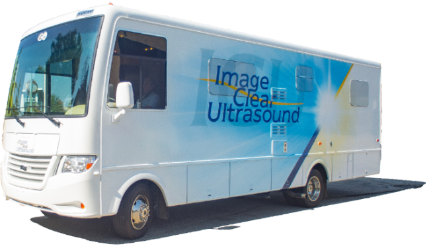Abortion
Abortion
Before going forward with an abortion, we recommend you obtain an ultrasound to determine that your pregnancy is viable, meaning in the uterus and developing as it should, based on the date of your last menstrual period. The Image Clear Ultrasound mobile team in your area can provide a free pregnancy test and ultrasound.
 Abortion Pill
Abortion Pill
The abortion pill is a procedure that uses two different medications. This procedure is sometimes called a medication, medical, or chemical abortion or a planned miscarriage. The FDA (U.S. Food & Drug Administration) has approved this procedure for pregnancies that are 70 days (10 weeks) or less since the first day of your last menstrual period (LMP). Mifeprex®, the brand name for mifepristone, is not approved for ending pregnancies that are further along.(1)
Mifeprex®, the first medication given in a medical abortion, blocks a hormone needed for your pregnancy to continue.(1) That hormone is progesterone. Progesterone causes the lining of your uterus to thicken to provide a supportive environment for a fertilized egg/embryo. Progesterone also helps maintain that supportive environment throughout pregnancy. Blocking progesterone leads to the breakdown of the lining of the uterus and the inability of the embryo or fetus to survive.
Misoprostol (also known as Cytotec®), the second medication used in this procedure, causes the uterus to contract and to expel the remains of the baby. This process can take from a few hours to a few days.
When considering a medical abortion, be aware of these FDA guidelines:
- Mifepristone (Mifeprex®) is approved for pregnancies that are 70 days (10 weeks) or less since the first day of your last menstrual period (LMP).
- A medical abortion requires at least two office visits and may require more.
- You should not pursue a medical abortion if you cannot follow up with your provider within 7-14 days of your first visit. A follow up assessment is essential to assure that the pregnancy has passed from your uterus.
The above is not a complete list of the FDA guidelines. To learn more, click here.
Sources
1 Mifeprex Medication Guide (retrieved on 6/29/20).
Abortion Pill Reversal
If you have taken the first medication (mifepristone/Mifeprex®) of the “abortion pill” but are rethinking whether to go forward with your abortion or have changed your mind, you’re not alone. The Abortion Pill Rescue Network answers more than 150 calls per month from women who regret taking the first abortion pill.
The good news is that it may be possible to reverse the effects of the mifepristone. The probability of success is greater the sooner you begin treatment, preferably within 72 hours of taking the first pill. The protocol used, progesterone therapy, has been used routinely and safely with pregnancy since the 1950s.
To learn more, you can reach the abortion pill rescue network by visiting Abortion Pill Reversal / Abortion Pill Rescue. The website has a chat option.
Or you may call 800.712.4357 or 877.558.0333 to discuss your options.
 Surgical Abortion
Surgical Abortion
Gestational age describes how far along a pregnancy is. It is measured in weeks, from the first day of your last menstrual period (LMP) to the current date. Surgical procedures used for abortion differ based on gestational age. Procedures at various stages also differ state to state. The information below is a general description of procedures used and may not completely describe those used in your area.
First Trimester
A first trimester surgical procedure, up through 13 weeks LMP, is referred to generally as aspiration, but also as manual vacuum aspiration, suction aspiration, or suction curettage.
A speculum is inserted into the vagina to bring the cervix into view. Your provider will use a tool called a tenaculum to hold the cervix in place. Your cervix will be numbed using a local anesthetic. Metal rods, called dilators, are typically used to stretch the opening of the cervix. Then a thin, hollow, plastic tube called a cannula is inserted into your uterus. It is attached to a handheld or electric suction pump, which removes the baby from your uterus. This may be followed by a procedure called curettage which involves insertion of a long instrument with a loop-shape at its end used to scrape the uterus to assure that the uterus is completely empty.
Second Trimester
During the second trimester (from about 14-24 weeks of pregnancy), a dilation and evacuation (D&E) procedure is used. Additional dilation is required beyond that used in first trimester aspiration. Laminaria, a dried seaweed product, which absorbs moisture and slowly opens the cervix, may be placed 24 to 48 hours before the abortion. Or misoprostol, one of the drugs used in a medication abortion may be used to soften the cervix. Once laminaria is removed, and if additional dilation is necessary, metal dilators may be used to further expand the cervical opening. Because the baby is larger, forceps are used to remove its extremities (arms, legs, head) from the body so that these body parts are small enough to be removed through the cervix and vaginal canal. Then a cannula is inserted into the uterus, and any remaining contents are suctioned out. This procedure may be followed with curettage and/or additional suctioning.
After having laminaria placed, it may be possible to change your mind about going forward with the abortion. There is a possibility that you may miscarry, but some women have changed their minds and successfully carried to term. If you change your mind about going through with an abortion after insertion of laminaria, we recommend you go to a local hospital emergency room or seek other medical attention as soon as possible.
Late Term
Late term abortion, from approximately 24 weeks of pregnancy may be accomplished by dilation and evacuation or by induction, that is by inducing labor. This is a multiple day procedure. On day 1, a large needle is used to inject potassium chloride or digoxin into the baby’s heart, causing its death. The cervix is softened and opened for 2-3 days using laminaria and/or vaginal medication.
On day 2, laminaria is replaced and an ultrasound performed to determine whether the baby has died. If not, a second injection of digoxin or potassium chloride is administered.
Labor-inducing drugs, such as Pitocin, are administered. Contractions like those experienced during labor will begin, and the baby will eventually be delivered. The time from beginning to the end of the procedure varies.
If the induction method fails or cannot be used, a D&E procedure like that used in the second trimester may be used. However, because of its advanced gestational age, the baby’s head may need to be crushed before removal.
Abortion Pill Medical Risks
If the abortion pill fails, you will need to seek a surgical abortion.
Other side effects of the abortion pill may include serious or life-threatening bleeding and serious or life-threatening infections.
In the Mifeprex/mifepristone Medical Guide, the FDA recommends you contact your health care provider if you experience
- heavy bleeding, (enough to soak through two thick, full-size pads per hour for two hours in a row).
- abdominal pain or “feeling sick,” (weakness, nausea, vomiting, or diarrhea with or without fever for more than 24 hours after taking misoprostol). These symptoms may be a sign of a serious infection or another problem including a pregnancy outside the uterus (link to ectopic pregnancy on this website).
- a fever over 100.4ºF or higher that lasts 4 or more hours. Fever may be a symptom of a serious infection or another problem.
If you cannot reach your medical provider, go to the nearest hospital emergency room.
If you have a medical abortion at home, it is recommended that you have
- phone access to a doctor who can answer questions
- access to emergency services
The FDA’s medication guide lists who should not take Mifeprex®.
Surgical Abortions Medical Risks
All surgical abortions carry the risk of
- heavy bleeding
- injury to the cervix, uterus, and other organs
- pelvic infection
- incomplete abortion (fetal parts or other pregnancy related tissue may not be completely emptied from the uterus)
- anesthesia-related complications when general anesthesia is used
- complications from abortion, especially infection, may make it difficult to become pregnant or to carry a future pregnancy to term
Induction Abortion Medical Risks
Induction Abortion carries the highest risk for complications such as infection and excessive bleeding. Additional risks include blood clots in the uterus and incomplete abortion. When medications are used to start labor, there is a risk of rupture of the uterus.
In late term abortion, there is a chance of the baby being “viable,” that is having the ability to live outside the uterus. Though rare, this means there is a chance that the baby intended to be aborted could be born alive. In most states, medical personnel have a responsibility to take all reasonable steps to maintain the life and health of the child.
Other Concerns
Some women report feeling relieved after their abortions—relieved that the decision was made, the procedure is over, and the experience has passed. However, some women report negative psychological, emotional, and relational problems. The following list of psychological effects connected to abortion are provided to make you aware of what you might experience. Many women experience at least one or more of these effects to varying degrees following an abortion—sometimes immediately, but sometimes years down the road.

Psychological, emotional, relational effects connected to abortion
- Anniversary reaction on date of abortion or baby’s due date
- Anxiety attacks
- Depression, hopelessness
- Desire to replace aborted baby
- Difficulty maintaining close relationships
- Flashbacks of the abortion experience
- Obsessive involvement in either pro-life or pro-abortion activities
- Sexual problems or dysfunction
- Uncontrollable crying
- Violent outbursts
This list is not exhaustive. If you suspect you are experiencing any negative consequences related to your abortion, we recommend you contact your healthcare provider or the Image Clear Ultrasound team in your community. They can direct you to where you may find help.
How much does an abortion cost?
Many factors affect the financial cost of an abortion including
- the geographic region of the country in which you reside
- The gestational age of the baby – which refers to the number of weeks since your last menstrual period (LMP)
- the type of procedure you have
The Image Clear Ultrasound team will be able to discuss all the above issues with you at your appointment.
Image Clear Ultrasound neither refers for, nor performs, abortions.

All Services Offered are Free
Pregnancy Testing, Ultrasound, and Community Referrals
